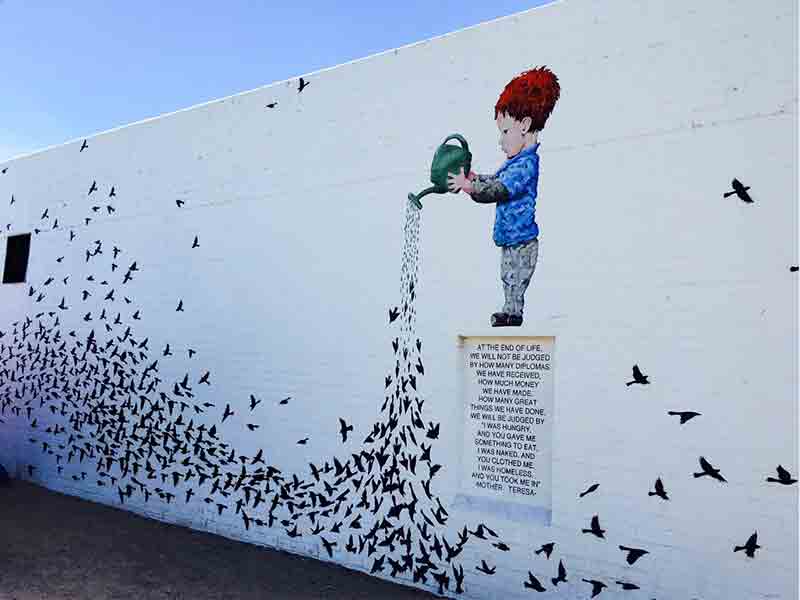A young boy stands before us on a tower of words, holding a green watering can spilling out hundreds of black birds. Nope, it’s not a magic show or the latest fantasy flick, it’s a street in downtown Phoenix. More specifically, a magnificent mural in the Roosevelt Row Arts District.
The locals call it RoRo and this creative arts district is the central hub for the arts, cultural events, galleries, music and restaurants. I have been to Phoenix on several occasions, but this was my first time travelling to the magnificent Sonoran Desert with my 11-year-old son, Noah.
The Phoenix Metropolitan Area is home to more than 20 incorporated cities, including Peoria, Glendale, Scottsdale, Tempe and Mesa, each one offering something unique. I have previously kayaked along the Salt River looking for wild horses and woken up at 4 a.m. to ride in a hot air balloon for a daring bird’s-eye view of the Valley of the Sun.
RoRo is a dynamic area with a long history dating back to the first concrete sidewalks being poured in 1909, three years before Arizona officially became the 48th state in 1912. What was once a district known for crime and poverty slowly transitioned into the flourishing arts neighbourhood it is today. The mural – a masterpiece project by creative painter Brian Boner, artist and homelessness activist Jon Linton, and the owner of the building, Wayne Rainey – was unveiled last year and illustrates a younger version of Boner’s son, Jasper. The mural depicts freedom from oppression and liberation. It is intended to raise awareness about homelessness and to be a tribute to the homeless people who have perished on city streets.
READ: SHABBOS IN SEOUL: THE PLEASURES OF SHUL IN FARAWAY PLACES
When we first happened upon a fence with clothing and accessories hanging off it, I started walking away. “Look! It’s a wall of kindness,” Noah said with interest. He knew it had special meaning, possibly because we have spent many years visiting people who live on the streets of our home town of Toronto. We have made sandwiches, bags of goodies decorated with colourful stickers, given out clothing and, more importantly, taken the time to sit and chat with individuals living on the street about their lives.
Next to the vintage shirts, pants and belts hanging on a makeshift shelf and left for those who may need it was a sign that read, “Wall of Kindness.” If one has something to spare, he or she can leave it; if someone need something, that person can take it. This unexpected message in downtown Phoenix reminded me immediately of the Jewish meaning behind the Hebrew word tzedakah. It’s traditionally translated as “charity,” but tzedakah actually means something slightly different. The world comes from the Hebrew root tzadei-dalet-qof and means justice, fairness, and righteousness. Therefore, giving to people in need is not necessarily charity, but rather an act of justice – it’s a person’s duty to help others. What a great lesson to teach kids while travelling.

Noah and I didn’t have any extra clothes to leave on the wall that day, but we were able to hand out some food we had purchased earlier at the Phoenix Public Market to a kind man with sad eyes who was very grateful. Like all big cities in North America, it is not difficult to find people in Phoenix who could use a dose of kindness, no matter how small.
Earlier in the week, we visited the Desert Botanical Garden and strolled through the massive 140 acres, checking out over 50,000 plant displays. For anyone who loves Sonoran desert cacti and discovering what makes them unique, it’s a wonderful place to visit. Anyone who goes in the summer months should bring water and a hat and visit early in the morning, as the sun is setting or join up with the official Flashlight Tour after sunset, which runs every Thursday and Saturday until September. Noah and I had dinner at Gertrude’s before our evening cactus exploration. This delicious restaurant is located inside the gardens and specializes in using fresh, local ingredients sourced from artisans and farmers around Arizona and the Southwest. Noah and I follow a plant-based diet and loved the grain bowl with tofu and colourful rainbow carrots.
Speaking of rainbow food, we were beyond thrilled to discover water-based rainbow Dippin’ Dots at our resort. We stayed at the Pointe Hilton Squaw Peak Resort, located in the heart of the Sonoran desert. Noah loved zooming down the water slide to cool off in the pool and splashing under the fountain. Later on, he made authentic salsa in the kids’ area, while I rejuvenated at the luxurious spa and sipped on cucumber water.
We visited the Arizona Science Center, where we learned about space in its huge planetarium and were educated on 3D printing from the Create Makerspace attraction – where science, inventions and creativity come together. Phoenix also boasts a funky Musical Instrument Museum, where one can learn about and play thousands of instruments from around the world, and the Heard Museum, which tells the story of the native people of the Southwest and includes displays of their historical art and cultural objects.
If anyone is wondering what the tower of words from the RoRo mural spells out, it’s the famous quote from Mother Teresa: “At the end of life we will not be judged by how many diplomas we have received, how much money we have made, how many great things we have done. We will be judged by, ‘I was hungry, and you gave me something to eat, I was naked and you clothed me. I was homeless, and you took me in.’”










